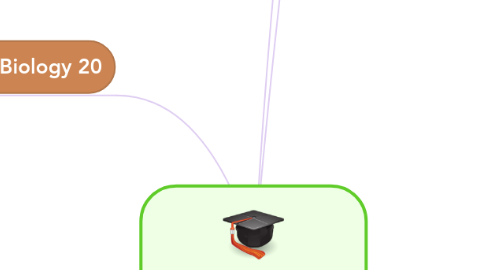
1. Biology 20
1.1. Unit D: Human Systems
1.1.1. Students will explain the role of circulatory & defence systems in maintaining an internal equilibrium (Alberta Education, 2007)
1.1.1.1. Specific Outcomes for Knowledge
1.1.1.1.1. Identify components (structures) of the circulatory system and how they function (Alberta Education, 2007)
1.1.1.1.2. Describe blood in terms of composition and its various functions (Alberta Education, 2007)
1.1.1.1.3. Describe how the circulatory system interacts with other organ systems in the body (Alberta Education, 2007)
1.1.1.2. Specific Outcomes for Science, Technology and Society
1.1.1.2.1. Applying scientific and technological developments using many perspectives - social, cultural, environmental, ethical and economic. (Alberta Education, 2007)
1.1.1.2.2. Explain how Canadian society supports scientific research and technological development to facilitate a sustainable society, economy and environment (Alberta Education, 2007)
1.1.1.3. Specific Outcomes for Skills (Nature of Science Emphasis)
1.1.1.3.1. Initiating and Planning: Formulate questions about observed relationships and plan investigations of questions, ideas, problems and issues (Alberta Education, 2007)
1.1.1.3.2. Performing and Recoding: Conduct investigations into relationships between and among observable and use a broad range of tools and techniques to gather and record data and information (Alberta Education, 2007)
1.1.1.3.3. Analyzing and Interpreting: Analyze data and apply mathematical and conceptual models to develop and assess possible solutions (Alberta Education, 2007)
1.1.1.3.4. Communication and Teamwork: Work collaboratively in addressing problems and apply the skills and conventions of science in communicating information and ideas and in assessing results (Alberta Education, 2007)
2. Building on previous knowledges
2.1. Science 10
2.1.1. Unit C: Cycling of Matter in Living Systems
2.1.1.1. Overview: The fundamental unit of life, the cell, is an example of an efficient open system comprised of a cell membrane and organelles that carry out the basic functions of all living organisms. Students will learn that technological advancements in microscopy have enhanced the study of cells and cellular processes. The understanding of life processes at the cellular level can also be applied to multicellular organisms.
2.1.1.2. Science Prerequisites Concepts: These concepts may be found in the following courses: − Life processes, and structure of plants Grade 7 Science, Unit B: Plants for Food and Fibre −Organisms, cells, system organs, tissues Grade 8 Science, Unit B: Cells and Systems
2.2. Science 8
2.2.1. Unit B: Cells and Systems
2.2.1.1. How does a healthy circulatory system function? (Alberta Education, 2003)
2.2.1.1.1. What organs/tissues play a crucial role in the circulation system. (Alberta Education, 2003)
2.2.1.1.2. Describe the circulatory system in general terms (Alberta Education, 2003)
2.2.1.1.3. How internal/external stimuli affect the functioning of this system (Alberta Education, 2003)
2.2.1.2. Exploring current scientific understandings and medical technologies pertaining to the circulatory system. (Alberta Education, 2003)
2.2.1.2.1. What diseases affect this system? (Alberta Education, 2003)
2.2.1.2.2. How has scientific research improved our knowledge on the system? (Alberta Education, 2003)
2.2.1.2.3. Exploring specific factors that affect the circulatory system in the context of human health. (Just a general understanding) (Alberta Education, 2003)
3. Common Misconceptions/Difficulties
3.1. The capillaries of the lungs have a filter function that oxygen is retained and carbon dioxide is eliminated (Wang, 2004).
3.1.1. Both oxygen and carbon dioxide molecules move through cell membrane of the capillaries through the process of diffusion. (Wang, 2004)
3.2. Contraction of heart is one of the factors that help blood return to the heart. (Alkhawaldeh, 2007; Sunnger et al., 2003; Yip, 1998).
3.2.1. The contraction of the heart, expels blood away from the heart. Circulation is dependent on systolic and diastolic stages of the cardiac rhythm.
3.3. "One of these misconceptions is that only the contraction of the heart chambers, but not their subsequent relaxation, is important in maintaining the blood flow" (Lee, 2001).
3.3.1. "The model demonstrates clearly that the relaxation of the heart chambers helps to draw blood from the periphery by means of suction, as evident from the deflation of the polyethylene bags when pressure on the 'ventricles' is released" (Lee, 2001).
3.4. When blood reaches the cells, some of it stays inside blood tubes and some leaves the blood tubes and bathes the cells. (Alkhawaldeh, 2007; Sunnger et al., 2003; Yip, 1998).
3.4.1. Blood never leaves the blood vessels.
3.5. When environmental temperature increases, skin tacks a red appearance because the velocity of the blood increases, or because the diameter of the capillaries increases or because the blood pressure increases. (Alkhawaldeh, 2007; Sunnger et al., 2003; Yip, 1998).
3.5.1. It's red because the arterioles vasodilate and bring more blood cells to the area.
3.6. Veins have the lowest blood pressure compared to other blood vessels because gravity interferes with blood flow. (Alkhawaldeh, 2007; Sunnger et al., 2003; Yip, 1998).
3.6.1. Veins have valves that allow the blood to travel upwards to the heart. Therefore, gravity does not diminish blood flow in the veins.
4. Importance of Bio 20 Knowledge
4.1. Basic understanding of more complex systems for application in Bio 30.
4.1.1. Biology 30
4.1.1.1. Describe the function of the hormones of the principal endocrine glands, i.e., insulin, antidiuretic hormone (ADH), epinephrine, aldosterone, and describe how they maintain homeostasis through feedback (Alberta Education, 2007)
4.1.1.2. Explain how the endocrine system allows humans to sense their internal environment and respond appropriately; e.g., calcium balance, osmotic pressure of blood (Alberta Education, 2007)
4.1.1.3. Regulation of blood sugar (Alberta Education, 2007)
4.1.1.4. Analyze blood hormone data and physiological events for a single menstrual cycle, inferring the roles of female sex hormones and analyze blood hormone data and physiological events, inferring the roles of male sex hormones (Alberta Education, 2007)
